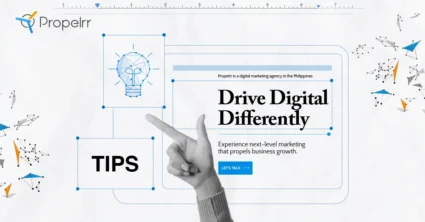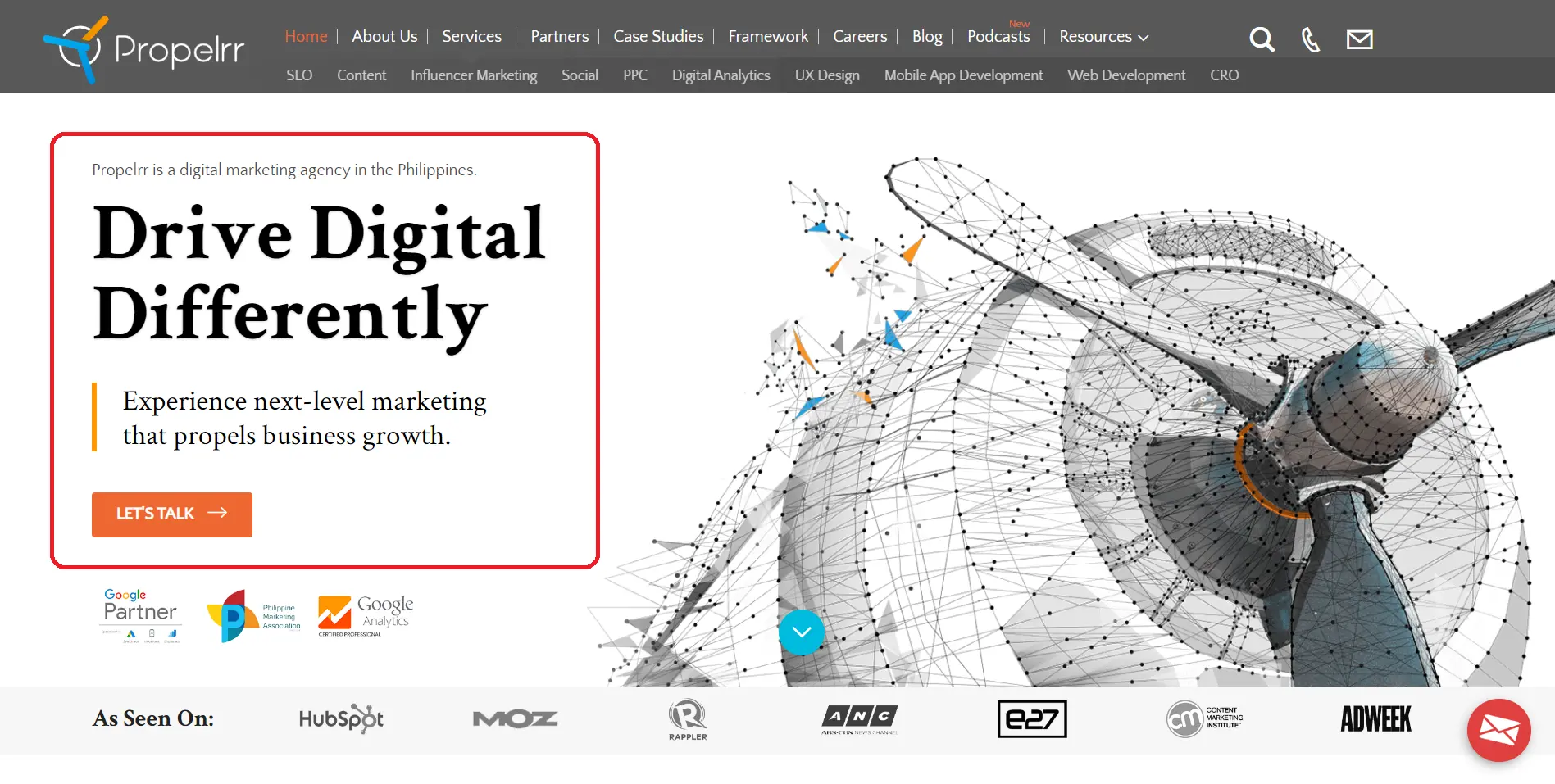7 Landing Page Copywriting Tips to Create Copies That Convert
Author & Editor
Copywriting Team Lead
Published on: Aug 23, 2023 Updated on: May 21, 2024

Table of Contents
Landing that perfect landing page copy for your website can often feel like a herculean task.
Landing pages are a crucial part of a content marketing strategy. They provide customers with pertinent business information that guides them through a conversion for your brand. In writing a winning caption for your website, you need to create a copy that fulfills the needs of both your customers and your company, all at the same time.
At a loss for how to write a landing page copy that helps you achieve your business goals? Don’t worry - even the experienced need copywriting tips and guidance to survive their content marketing work these days.
At Propelrr, we believe in the power of A/B testing when we want to create landing pages that convert for our clients. Discover expert ways to copywrite like a pro when you incorporate A/B analysis into your content marketing strategy right now.
Basics of landing page copywriting
Landing page copywriting is the practice of writing text copies like headlines, subheadings, meta descriptions, calls-to-action (CTAs), and more, to drive customer actions on a brand’s landing page or website.
A good copy should be persuasive and compelling. It should convince readers to pay attention to your brand so that they might be persuaded to complete an action on your site. As a digital marketer, you often practice landing page copywriting to optimize pay-per-click (PPC) executions and drive better conversions for your brand’s website.
In a landing page checklist, the best practices for writing include:
- Offer a clear value proposition. This is what immediately informs users of what you have to offer, and why they should value your business. A clear value proposition answers a problem that potential customers want to have solved.
- Give a specific CTA. A CTA, on the other hand, makes site visitors more curious about your brand and calls them to do a specific action that satisfies their curiosity. This is how you ensure direct response copywriting converts for your site.
- Test your copies. Once you’ve written excellent copies for your site, you need to test them out to see if they actually work for their intended purpose.
The first two practices are pretty straightforward - all you need to do is to write a copy with a clear value proposition and specific CTA. But how exactly do you plan on testing out your copies to make sure that they actually work? This is where the magic of A/B analysis comes into play.
Creating landing pages that convert with A/B testing
A/B testing, also known as split testing, is the process of testing two versions of a marketing execution to see which version performs better than the other. Examples of test-worthy content marketing executions can include landing pages, website, ads, emails, and more.
When you apply this experimentation strategy to your copies, you can gain a baseline that shows if your conversion copywriting requires further improvement or not. A/B analysis gives you further insights on the text, tone, and phrasing that works best for your audiences and optimization needs overall.
The various elements of landing page copywriting that can be experimented on can include texts like:
- Headlines
- Descriptions
- CTAs
- Display URLs
- Layout

Photo courtesy of Propelrr
The data you gather from split testing can help you make important decisions that’ll make (or break) the success of your website’s own conversions. This is why A/B testing matters in copywriting - it can guide you towards discovering ways in which you can drastically improve your brand page’s performance today.
How to test your landing page copywriting examples
Given the relevance of A/B tests in driving successful site conversions, it’s important for you to learn exactly how to run a successful experiment for your site. Here is your comprehensive step-by-step guide to conducting split tests for your landing page copywriting examples:
1. Identify your objective.
Before you begin any test or analysis, you need to identify your objectives for the exam first. Are you conducting an experiment to help your site gain more traffic? Are you testing out your headlines to find the version that gets the most clicks? Without a specifically identified objective, your A/B analysis might end up being vague and unclear.
Let's say you’re writing to drive better conversions. In identifying this objective, you’ll be able to better identify the conversion optimization metrics needed to measure the success of your campaign, like your click-through rate, post engagement, conversions, and more.
2. Formulate a clear hypothesis.
A hypothesis is a statement that poses a question to be answered by your experiment. This hypothesis should help you figure out what needs to be improved in your current copywriting process.
To formulate a hypothesis, make sure to refer to past data from previously run tests or copies. This self-referral will help you assess what did or didn't work for your writing in the past. With this review of your copy's performance, you can understand what has been achieved and discover what needs to be improved for your brand.
3. Define your test variables.
There are two main variables in a split test. The first is your “control” variable or version A, which is the current copy or text you have running on your platform. The second is your "challenger" variable or version B, which is the text you want to test against your current copy or control variable.
The identification and separation of these two variables is where the name for A/B testing comes from. It’s important to define your control variable and challenger variable too. By defining these two variables in an experiment, you’ll know with certainty which changes actually helped you achieve your initially determined objective.
This is why you only change one variable at a time when experimenting with your copy throughout the whole process - which is something you'll learn more about in the next step of this guide.
4. Test one variable at a time.
A common A/B testing mistake that people often make is pitting two wildly different texts or copies against each other. When you do this, you make it more difficult to identify exactly how and why a copy or text performed the way it did on your website or brand platform in the past.
To properly monitor your findings and identify the winning version of your copy, test one variable at a time. This variable might refer to your font choice, text size, or color choice. Select a specific variable to change before running any marketing experiments, and test it to see if it helps to achieve your marketing goal.
5. Run and document the test.
Once you have your objective, hypothesis, and variables in place, you can finally run your split analysis. Remember to keep all other variables untouched to get the most accurate results from your campaign.
Once you get your results, make sure to document your data accurately as well. This will allow you to refer back to your insights when you run another A/B test for your business’ content marketing needs.
6. Run and document the test.
With a duly completed A/B test, you can compare results between the control and challenger variables of your website copy. Identify which version achieved your overall objective best, and then use your collected findings to improve upon your platform’s existing text.
You can also further analyze your data to explore other hypotheses for your copywriting. To further improve your work and gain more insights into your optimization needs, remember to test the next potential variable in your copy ASAP.
7. Run and document the test.
Done with one experiment? Move on to the next variable for optimization and improvement. There will always be new variables to test your marketing for after all.
It's important to start testing your copies early and often because a complete optimization of your copywriting strategy requires a lot of tests and a lot of time. By testing early and often, you can develop better iterations of your texts to ensure the most optimal results for your platform today.
So remember to keep experimenting, optimizing, and improving your copies to drive better conversion wins for your business in the long run.
Successfully tested landing page copywriting examples
Want some added guidance on how to successfully test your copywriting? Here are two examples of businesses that recently ran A/B tests as a part of their efforts to improve their own platform conversions:
- OSP International LLC - A US-based brand dedicated to helping professionals get certified with its review tools, OSP International LLC ran multiple optimization strategies on its website to lift its conversion rates. With Propelrr’s help, this company ran split URL tests on select pages, thus achieving a 44% lift on their homepage and 78% lift on their main product page.
- Scribendi - This editing and proofreading service received its own proofreading makeover for its homepage when, with the help of Stripe, it revised its social proof copywriting to reflect more visually descriptive statistics.
Landing page copy best practices to improve conversions
These steps and specific tips should be more than enough to jumpstart your copywriting journey today. But before you go, try out these effective best practices out for size to improve your own platform’s conversion rates in the future:
- Keep it simple. When readers read information on your brand’s website, they should instantly understand what your business is talking about. Keep things simple to avoid confusing content that'll drive potential customers away.
- Highlight your value proposition. This is crucial - make sure to highlight your plans to eliminate a user's pain points through your brand’s unique value proposition.
- Use the power of social proof. When you make an incredible offer or claim with your copy, back it up with trustworthy social proof. Social proof can come in the form of reviews, testimonials, or anything else that adds weight to your claim and builds trust in your content marketing.
- Write with a sense of urgency. Do this with actionable CTAs that are specific and easy to read, like "Subscribe Now" or "Download Today."
With well-written and properly tested copies, you can create excellent brand platforms that will drive performance wins for your business website this year.
Key takeaways
Create copies that convert with winning writing techniques and accurate A/B tests today. Bring these final takeaways with you as you pursue the best possible text for your brand platforms this year:
- Read up on best writing practices. By constantly updating your writing practices, you can gain a baseline for your copywriting skills and ensure you're writing good content for your website from the very start.
- Test early, test often. By starting early and experimenting several times, you'll collect more and more data to improve your writing in the future.
- Work with fellow copywriting experts. By leveraging expert digital marketing services for your writing, you'll get the best possible results for all your brand's landing page optimization needs.
If you have any other questions, send us a message via our Facebook, X, and LinkedIn accounts. Let’s chat!
Subscribe to the Propelrr newsletter as well, if you find this article and our other information helpful to your needs.
